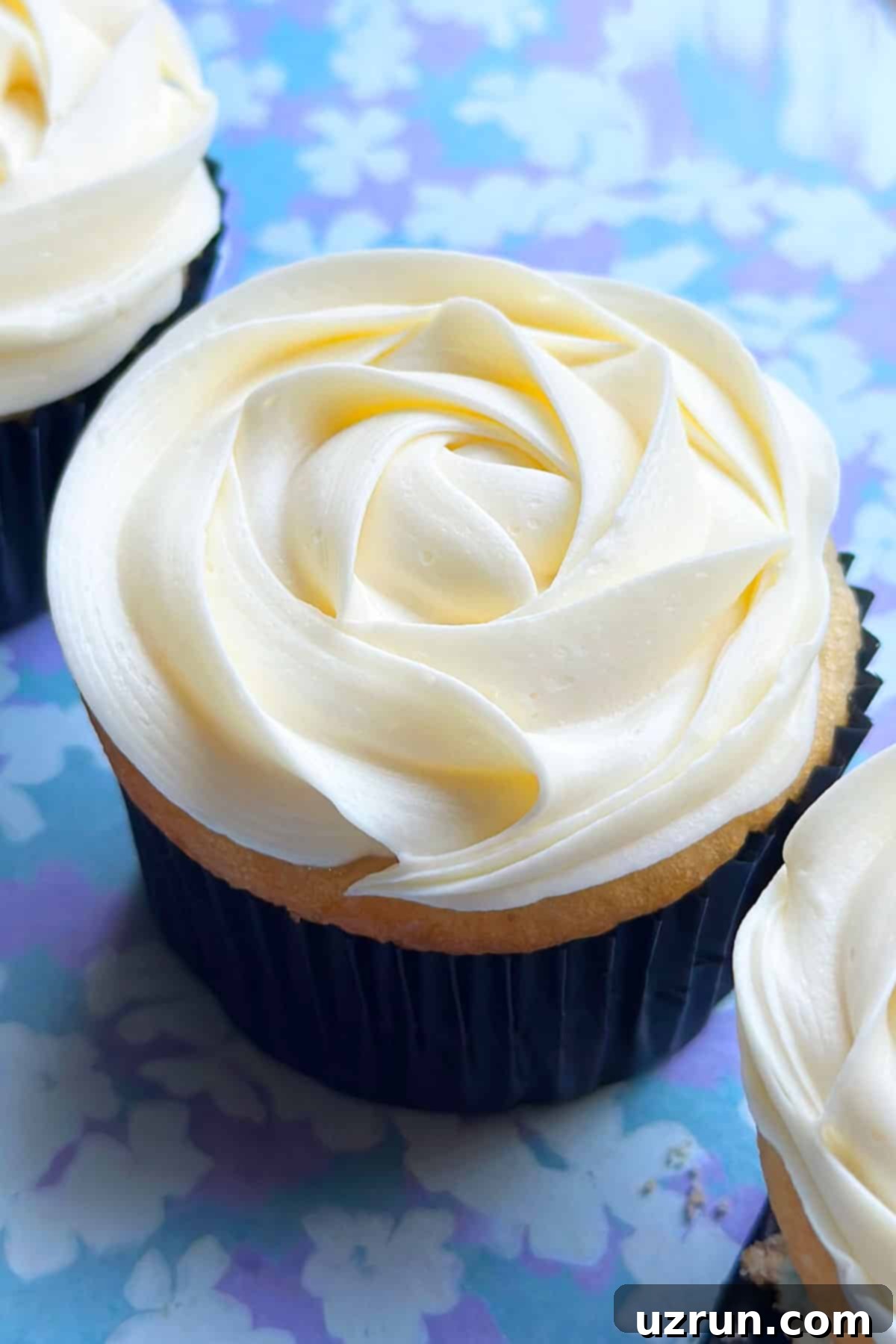Easy Homemade Almond Buttercream Frosting: Your Ultimate Guide to Fluffy Perfection
Discover the secret to the most irresistible and versatile almond buttercream frosting. This homemade recipe, crafted with just 5 simple ingredients, delivers a luxuriously smooth, incredibly fluffy, and delightfully creamy texture that’s perfect for a myriad of desserts. Infused with a harmonious blend of vanilla and almond extracts, it offers a sophisticated flavor profile that elevates everything from elegantly piped swirls on wedding cupcakes to festive birthday cakes and delicate cut-out sugar cookies. Whether you’re a seasoned baker or just starting, this easy almond icing recipe is designed to help you achieve bakery-quality results right in your own kitchen.
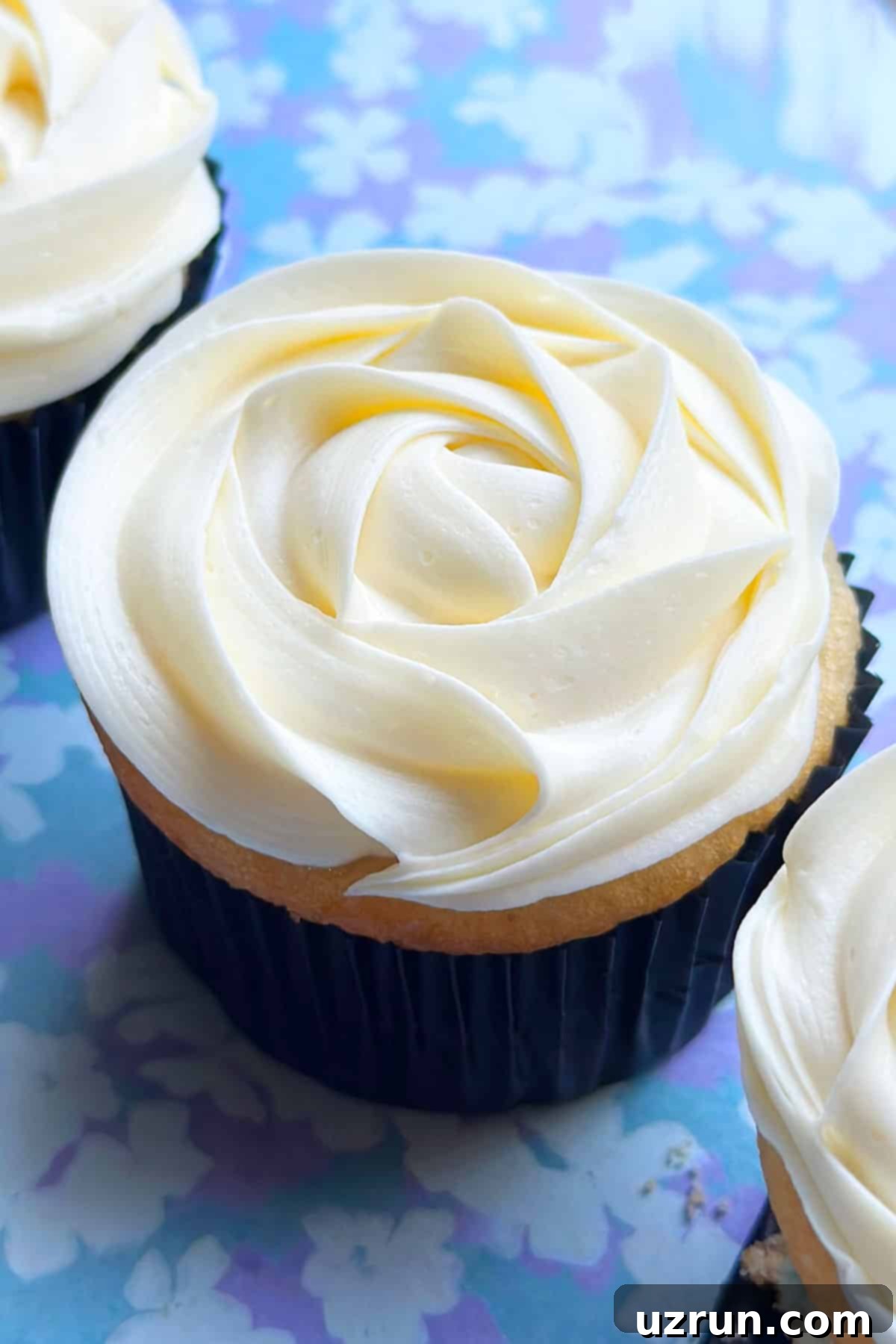
Why Choose Almond Buttercream for Your Next Dessert?
There’s something uniquely enchanting about almond flavor. It’s subtle yet distinctive, offering a nutty sweetness that complements a wide range of desserts without being overly rich or artificial. Unlike more common flavorings, almond extract brings a certain elegance and depth, making this buttercream a cherished favorite for both grand celebrations and simple, comforting treats. It’s a flavor that evokes warmth, sophistication, and a hint of something truly special, transforming ordinary baked goods into extraordinary culinary delights that will impress everyone.
The Perfect Flavor Profile: Vanilla & Almond Harmony
Achieving the perfect flavor balance is paramount for a truly outstanding almond buttercream. While my mom’s classic recipe relied solely on almond extract, I found that approach could sometimes lead to an overwhelming, almost medicinal taste that didn’t quite hit the mark. Through extensive testing and a quest for perfection, I discovered that a harmonious blend of half vanilla extract and half almond extract creates a much more nuanced, well-rounded, and utterly delightful flavor profile. The vanilla gently mellows the intensity of the almond, adding a layer of comforting warmth and sweetness that makes this frosting unbelievably delicious. This exquisite balance is particularly divine when paired with delicate treats like my renowned White Wedding Cupcakes. With its irresistibly velvety texture and enchanting aroma, this frosting can elevate any dessert into a truly divine indulgence. If you’re passionate about the unique, nutty essence of almond, be sure to explore other almond-infused delights such as Banana Almond Biscotti, traditional Italian Almond Cookies, and the delicate Almond Crescent Cookies to further satisfy your almond cravings.
[feast_advanced_jump_to]
Essential Ingredients for Perfect Almond Buttercream
Crafting flawless almond buttercream begins with understanding the role of each key ingredient. Here’s what you’ll need and why each component is vital for achieving the best results:
- Unsalted Butter: This forms the rich, creamy foundation of our buttercream. It’s absolutely crucial that your butter is at true room temperature. This means it should be soft enough to indent easily with your finger, but not melted or greasy. Room temperature butter creams beautifully, incorporating air efficiently to create a light, fluffy texture and preventing lumps. Using unsalted butter allows you to control the exact amount of salt in your frosting.
- Vanilla Extract: A classic and indispensable ingredient in almost all buttercream recipes. Vanilla extract adds a layer of comforting sweetness and depth, acting as a perfect counterbalance to the distinct almond flavor. For the richest taste, always opt for high-quality pure vanilla extract; imitation vanilla can leave an artificial aftertaste that detracts from the overall flavor.
- Almond Extract: The star ingredient that imparts this frosting with its signature, unique nutty flavor. Just like vanilla, the quality of your almond extract matters immensely. Pure almond extract delivers an authentic, vibrant taste, whereas imitation versions can taste overwhelmingly artificial or “medicinal.”
- Powdered Sugar (Confectioners’ Sugar): This fine sugar provides the primary sweetness and structural integrity for the frosting. It is absolutely essential to sift your powdered sugar before adding it to the butter and extracts. This crucial step eliminates any existing lumps or hardened bits, ensuring your buttercream is unbelievably smooth, silky, and free from any grainy texture whatsoever.
- Milk (or Heavy Cream): This liquid component is used to adjust the consistency of your frosting to perfection. Start with a small amount and gradually add more, a tablespoon at a time, until you achieve your desired thickness. Whether you need a stiff frosting for intricate piping designs or a softer consistency for easy spreading, milk helps you tailor the buttercream. For an even richer and more decadent frosting, consider substituting milk with heavy cream.
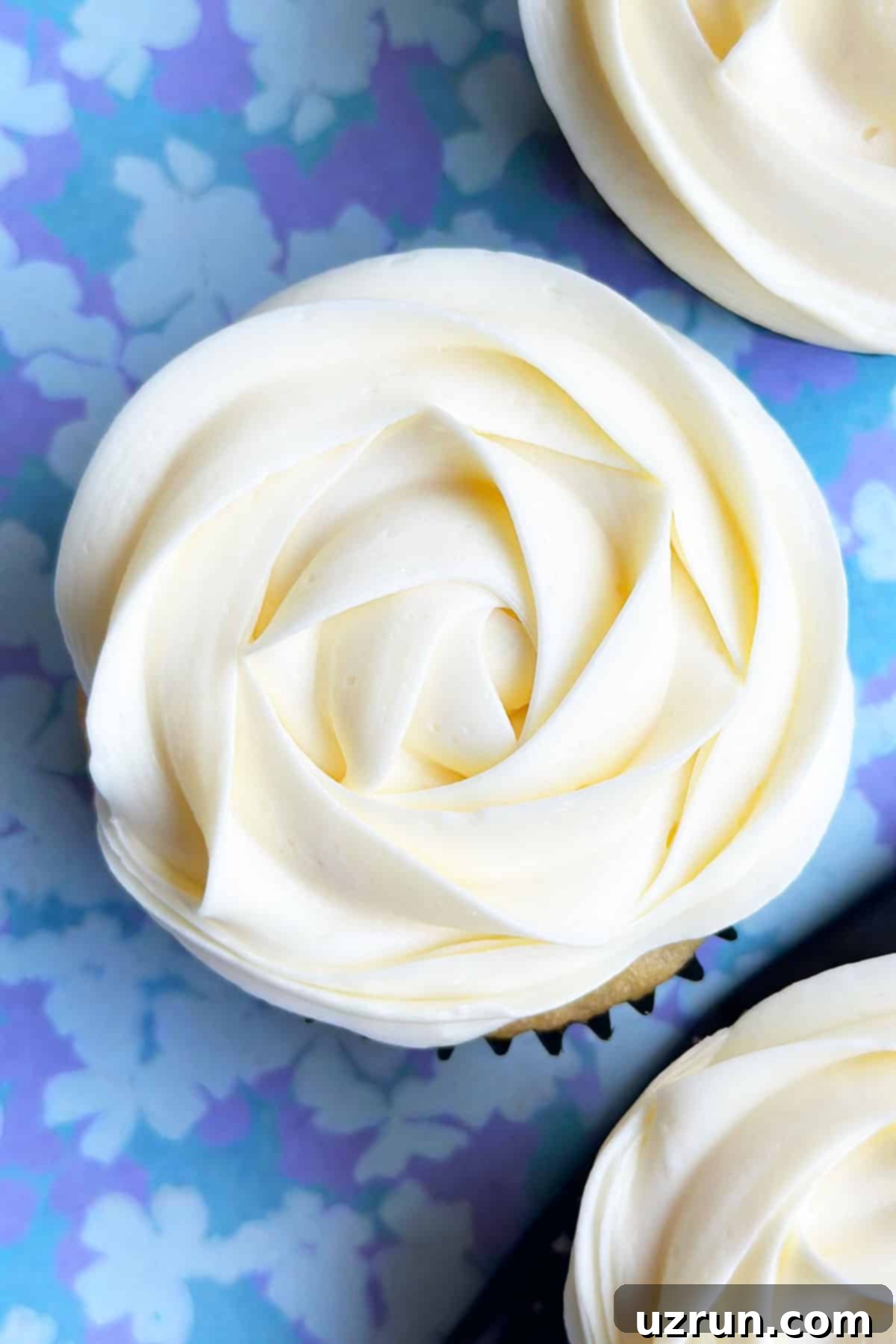
Creative Variations and Customizations for Your Almond Buttercream
This classic almond buttercream recipe is wonderfully adaptable, allowing you to customize it to suit any occasion, aesthetic, or even dietary need. Here are some popular variations to inspire your next baking project:
- Mastering Cupcake Decorating: If you’re new to the delightful art of cupcake decoration, don’t feel intimidated! This frosting is incredibly beginner-friendly and holds its shape beautifully. For comprehensive guidance on various piping techniques and frosting methods, be sure to consult our detailed guide on How to Decorate Cupcakes (Pipe or Frost Cupcakes). It includes a helpful video tutorial and step-by-step pictures that you will find invaluable for getting started.
- Elegant Rose Piping: To create stunning and intricate rose designs, as often showcased in professional bakeries and in the accompanying images, this almond buttercream holds its form exceptionally well. Learn the specific techniques required to pipe perfect floral details by visiting our dedicated post on How to Pipe Red Rose Cupcakes.
- Enhance Creaminess with Heavy Cream: For an even richer, more luxurious, and decadent frosting that truly melts in your mouth, consider substituting the milk with heavy cream. This simple swap will yield an ultra-creamy texture and a slightly richer flavor, perfect for a truly indulgent dessert experience.
- Vibrant Food Coloring: Since this buttercream naturally boasts a beautiful white or pale cream color, it serves as an excellent canvas for adding vibrant hues. Always opt for high-quality gel food coloring, as these are highly concentrated and will not introduce excess moisture that can thin out your perfectly whipped frosting. Liquid food coloring can significantly alter the consistency.
- Increase Stability with Shortening: For situations where your desserts might be exposed to warmer temperatures – think outdoor parties or humid climates – or if you simply prefer a brighter white frosting, consider using a combination of half butter and half high-quality shortening. Shortening helps stabilize the buttercream, making it more resilient to heat, and contributes to a noticeably whiter finish.
- Funfetti Extravaganza: Transform this elegant almond frosting into a playful and festive Funfetti Frosting by simply folding in a generous amount of your favorite sprinkles. This variation is perfect for birthdays, children’s parties, or whenever you want to add a vibrant pop of color and joy to your baked goods.
- Vegan-Friendly Option: To make this a delightful vegan frosting, replace the dairy butter with a good quality plant-based shortening or a vegan butter alternative. Keep in mind that vegan alternatives may slightly alter the overall flavor and texture compared to traditional butter, but it will still yield a wonderfully delicious option for those with dietary restrictions or preferences.
Crafting Easy Almond Buttercream Frosting from Scratch: Step-by-Step Guide
Making this delightful almond buttercream is incredibly straightforward and requires minimal effort for maximum deliciousness. Follow these simple steps for a perfect batch every single time:
- Cream Butter and Extracts: In a large mixing bowl, preferably using an electric stand mixer fitted with the paddle attachment (or a sturdy hand mixer), combine your room temperature unsalted butter with both the vanilla and almond extracts. Beat on medium speed for 2-3 minutes until the mixture is light, incredibly creamy, and thoroughly well-combined. Make sure to scrape down the sides of the bowl periodically to ensure all ingredients are evenly incorporated.
- Gradually Add Powdered Sugar: With the mixer set to low speed to avoid a cloud of sugar, begin adding the sifted powdered sugar, about half a cup at a time. This gradual addition ensures smooth incorporation and prevents the mixture from becoming too dense too quickly. Continue mixing until all the sugar is added and fully blended. At this stage, the mixture will be quite thick and somewhat crumbly.
- Achieve Desired Consistency with Milk: While continuing to mix on low speed, slowly pour in the milk (or heavy cream), adding one tablespoon at a time. Carefully observe the consistency of the frosting as you add the liquid. Continue adding until the buttercream reaches your desired spreadable or pipeable consistency. For stiff piping, use less milk; for a thinner glaze-like frosting, add a bit more. Once the desired consistency is achieved, increase the speed to medium-high and beat for another 1-2 minutes until the frosting is incredibly light, airy, fluffy, and perfectly smooth. This final whip adds crucial volume.
- Decorate and Enjoy: Your luxurious almond buttercream is now perfectly ready for use! Transfer it to a piping bag or a spatula and use it immediately to frost your favorite cooled cakes, cupcakes, or cookies. Enjoy the fresh, delightful flavor and wonderfully smooth texture that you’ve created from scratch.
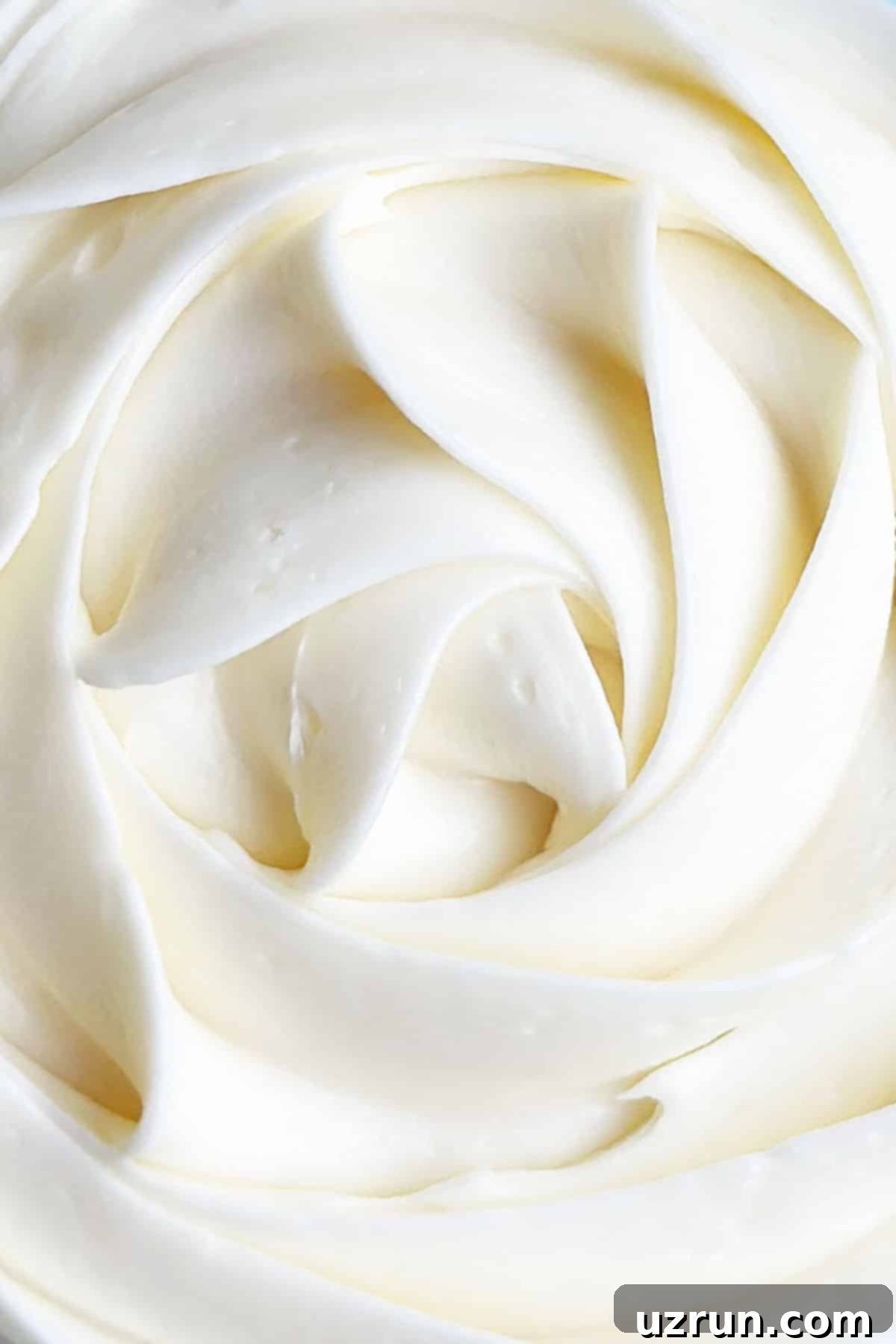
Expert Tips and Techniques for Flawless Almond Buttercream
Achieving bakery-perfect almond buttercream is simple when you know a few insider tips and tricks. These techniques will help you create a consistently smooth, fluffy, and delicious frosting every time:
- Opt for Clear Extracts for a Pristine White: If a brilliantly white frosting is your specific goal – perhaps for elegant wedding cakes or specific color themes – always choose clear vanilla and almond extracts. Regular extracts have a slight amber tint that can impart an “off-white” or creamy hue to your final product, which might not be what you’re aiming for.
- Quality Extracts Make All the Difference: Never compromise on the quality of your extracts. High-quality pure vanilla and almond extracts provide a rich, authentic flavor and a captivating aroma that elevates your buttercream. Imitation extracts often contain artificial ingredients that can leave an unpleasant aftertaste and an unappealing smell, significantly detracting from the overall deliciousness of your frosting.
- Room Temperature Butter is Non-Negotiable: Ensure your unsalted butter is at true room temperature. Butter that is too cold will result in a lumpy, difficult-to-mix frosting that won’t aerate properly. Conversely, butter that is too warm or melted will make your buttercream greasy, separated, and unable to hold its shape for piping or spreading.
- Sift Powdered Sugar for Silky Smoothness: This step is absolutely paramount for achieving a truly smooth and velvety buttercream. Sifting powdered sugar removes any existing lumps, hardened bits, or fine debris, ensuring that your frosting is incredibly smooth, creamy, and completely free from any grainy texture. Do not skip this crucial step for the best results.
- Adjusting Consistency – If Too Thick: Should your icing turn out too thick for comfortable piping or spreading, simply add more milk (or heavy cream) one teaspoon at a time. Mix thoroughly after each addition until you effortlessly reach your desired, pliable consistency. Patience here prevents over-thinning.
- Adjusting Consistency – If Too Thin: Conversely, if your icing becomes too thin or runny, gradually beat in more sifted powdered sugar, adding about ¼ cup at a time. Continue mixing until the ideal thickness is achieved, allowing the sugar to absorb excess liquid and stiffen the buttercream.
- Whip for Maximum Fluffiness: After all ingredients are combined and the desired consistency is reached, don’t stop mixing! Beat the buttercream on medium-high speed for an additional 1-2 minutes. This crucial step incorporates more air, making the frosting extra light, incredibly fluffy, and much easier to work with, especially for piping.
- Coloring Your Frosting: When adding color to your buttercream, always use high-quality gel food coloring. Gel colors are highly concentrated, provide vibrant hues with minimal product, and, most importantly, will not thin out your perfectly whipped buttercream like watery liquid food colorings can. Add a tiny amount at a time and mix until the desired shade is reached.
- Yield Information: This recipe generously yields approximately 2 cups of almond buttercream. This quantity is typically sufficient to generously frost about 24 standard cupcakes using a simple spatula application (without high, elaborate swirls) or to completely cover and decorate one 8×2 inch round cake. Adjust quantities proportionally if you require more for elaborate decorations or larger baking projects.
- Re-whipping Chilled Buttercream: If you’ve stored your buttercream in the refrigerator, it will naturally firm up considerably. Before using, allow it to come to room temperature for approximately 30-60 minutes, then re-whip it with your mixer for a few minutes. This process restores its original light, fluffy, and smooth consistency, making it easy to pipe or spread beautifully again.
Common Questions About Almond Buttercream Frosting
Your buttercream likely became too thin because too much liquid (milk or extract) was added during mixing, or perhaps not enough powdered sugar was incorporated to provide sufficient structure. Don’t worry, it’s an incredibly easy fix! Simply add more sifted powdered sugar, about ¼ cup at a time, mixing thoroughly after each addition until the frosting reaches your desired thicker, pipeable consistency. This will absorb excess liquid and stiffen the buttercream effectively.
A buttercream that is overly thick often indicates an excess of powdered sugar or insufficient liquid (milk/cream) being added. To remedy this, gradually add more milk or heavy cream, one teaspoon at a time, mixing well after each addition. Continue this process until the frosting achieves the perfect, smooth consistency for easy spreading or piping without resistance.
Yes, absolutely! Almond milk is an excellent and highly recommended substitute for regular dairy milk in this recipe. It blends seamlessly, maintaining both the desired creamy texture and the delicious flavor profile without any compromise. It’s a fantastic option for those looking for a dairy-free or plant-based alternative.
Lumps and a grainy texture are usually caused by one of two main factors: either the powdered sugar has not been properly sifted, or the butter was too cold when you started mixing. Powdered sugar often contains small, hard clumps, which sifting effectively eliminates. If your butter isn’t at the proper room temperature, it won’t cream smoothly with the sugar, leading to noticeable lumps and an undesirable texture. Always ensure both ingredients are prepared correctly for a truly smooth result.
Buttercream is highly sensitive to temperature extremes. If your ingredients (especially the butter) were either too cold or too hot when you began mixing, or if the ambient temperature of your kitchen is excessively hot, the emulsion can break. This causes the buttercream to appear curdled or separated. For a split frosting, sometimes gently warming a small portion and slowly re-incorporating it into the main batch, or adding a tablespoon of warm milk while continuously mixing, can help bring it back together into a smooth consistency.
Delightful Serving Suggestions for Almond Buttercream
This versatile almond buttercream isn’t just limited to frosting cupcakes and cakes. Its rich flavor and smooth texture make it an incredible addition to a wide array of desserts. Here are some delicious ideas to inspire your next culinary creation:
- Dipped Cookies: Elevate simple shortbread, biscotti, or plain sugar cookies by dipping half of them into this almond buttercream. It adds an extra layer of almond flavor and a beautiful finish.
- Filling for Macarons: Its light, yet stable texture makes it an ideal, elegant filling for delicate almond macarons, enhancing the overall almond experience of these classic French treats.
- Brownie Topping: Spread a generous, smooth layer of almond buttercream over cooled fudgy brownies for an elevated dessert that combines rich chocolate with nutty sweetness.
- Donut Glaze or Filling: Use it as a delightful, creamy glaze for baked donuts, or pipe it directly into homemade yeast donuts for a luxurious and flavorful filling.
- Crepes and Pancakes: A dollop of this exquisite buttercream can transform ordinary breakfast or brunch items like crepes, pancakes, or waffles into a special, indulgent treat.
- Dessert Bars: Use it to top various dessert bars, such as blondies, lemon bars, or even fruit bars, adding a layer of creamy richness and a distinctive almond note.
- Cupcake & Cake Piping: Of course, it’s quintessential for piping beautiful swirls on cupcakes or for decorating multi-layered cakes for any festive occasion.
Proper Storage for Freshness and Longevity
Properly storing your homemade almond buttercream is crucial to ensure its freshness, maintain its perfect texture, and allow you to enjoy it for an extended period without compromise:
- Room Temperature: Due to the presence of perishable dairy ingredients in this recipe (butter and milk/cream), this buttercream should not be left at room temperature for more than 2-3 hours. If you’re actively working on decorating, keep any unused portions chilled to maintain food safety and prevent spoilage.
- Refrigeration: Leftover almond buttercream can be stored beautifully in an airtight container in the refrigerator for up to 1 week. When you’re ready to use it again, allow it to come to room temperature for at least 30-60 minutes, then give it a good re-whip with your electric mixer for a few minutes until it regains its original smooth, light, and fluffy consistency.
- Freezing: For longer storage, almond buttercream freezes exceptionally well. Place it in a freezer-safe, airtight container, ensuring there’s minimal air contact, and store for up to 1 month. To use, simply thaw the frozen buttercream overnight in the refrigerator. Once thawed, bring it to room temperature and re-whip thoroughly until it is light, fluffy, and ready for application.
- Make Ahead Option: This recipe is incredibly convenient for preparing in advance. You can make the buttercream up to 1 week ahead of time if you plan to store it in the refrigerator, or up to 1 month ahead if you opt to freeze it. Always remember the crucial step of bringing it to room temperature and re-whipping it before application for the best possible results and texture.
Explore More Delicious Homemade Frosting Recipes
If you’ve enjoyed making this almond buttercream, you’ll love exploring other frosting creations. Expand your baking repertoire with these fantastic homemade frosting recipes:
- White Chocolate Buttercream Frosting
- Marshmallow Frosting
- Chocolate Buttercream Frosting
- Blackberry Buttercream Frosting
- Lemon Frosting
Recipe Card
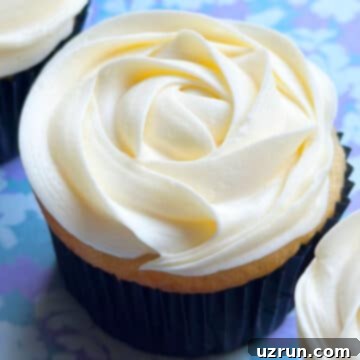
Easy Almond Buttercream Frosting
Abeer Rizvi
Pin Recipe
10 minutes
10 minutes
Dessert
American
2
Cups
1772
kcal
Want to Save This Recipe?
Enter your email & I’ll send it to your inbox. Plus, get great new recipes from me every week!
By submitting this form, you consent to receive emails from CakeWhiz
Ingredients
-
1
cup
Butter
Unsalted, Room temperature -
1
teaspoon
Vanilla extract -
1
teaspoon
Almond extract -
4
cups
Powdered sugar
Sifted -
3-4
tablespoon
Milk
Or heavy cream, More or less depending on the consistency you want
Instructions
-
In a large mixing bowl, combine your room temperature butter with both the vanilla extract and almond extract. Beat on medium speed until the mixture is light, creamy, and well-combined, typically for 2-3 minutes.
-
Gradually add the sifted powdered sugar (½ cup at a time) to the mixture, continuing to beat on low speed until all the sugar is incorporated and blended smoothly.
-
While continuing to mix on low speed, add the milk (1 tablespoon at a time) until you reach the desired consistency for your frosting. Once the desired consistency is achieved, beat on medium-high speed for another 1-2 minutes until light and fluffy.
-
Your luxurious almond buttercream is now ready to frost your cooled cakes and cupcakes. Enjoy!
Notes
- If the icing is too thick, simply mix in a little more milk (or heavy cream), one teaspoon at a time, until the desired consistency is reached.
- If the icing is too thin, gradually mix in more sifted powdered sugar, about ¼ cup at a time, until it thickens to the right consistency.
- Always sift your powdered sugar first to remove any lumps. This crucial step ensures the smoothest, most velvety icing every time.
- For a truly pristine white color in your frosting, it is best to use clear vanilla and almond extracts.
- Leftovers can be stored in a sealed airtight container in the fridge for up to 1 week. Remember to re-whip it after bringing to room temperature.
- This recipe yields enough icing to generously frost about 24 standard cupcakes with a spatula (without high, elaborate swirls) or one 8×2 inch round cake.
- For more detailed advice and additional creative ideas, refer to the “Tips and Techniques” and “Variations” sections above.
Nutrition
Calories:
1772
kcal
Carbohydrates:
241
g
Protein:
2
g
Fat:
93
g
Saturated Fat:
59
g
Polyunsaturated Fat:
3
g
Monounsaturated Fat:
24
g
Trans Fat:
4
g
Cholesterol:
247
mg
Sodium:
744
mg
Potassium:
72
mg
Sugar:
236
g
Vitamin A:
2873
IU
Calcium:
58
mg
Iron:
0.2
mg
An automated tool is used to calculate the nutritional information. As such, I cannot guarantee the accuracy of the nutritional information provided for any recipe on this site.
Tried this recipe?
Leave a comment below or rate and tag @cakewhiz on social
